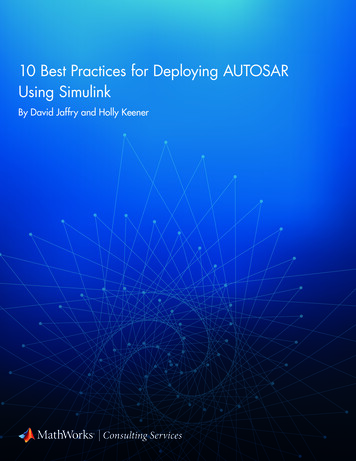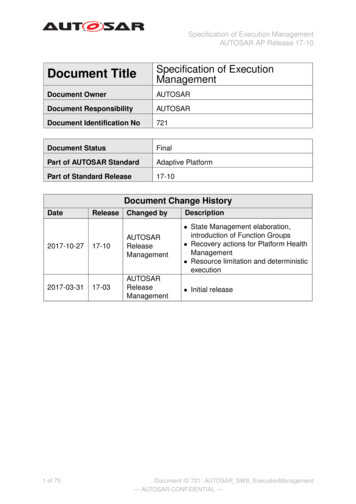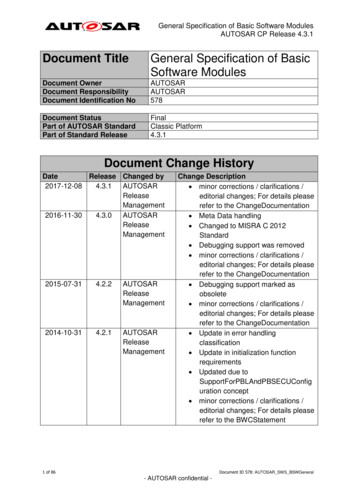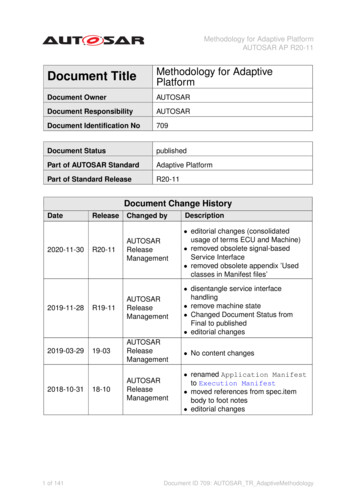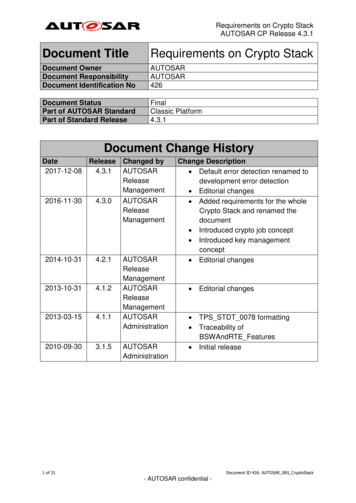
Transcription
Specification of Network ManagementAUTOSAR AP R20-11Document TitleSpecification of NetworkManagementDocument OwnerAUTOSARDocument ResponsibilityAUTOSARDocument Identification No898Document StatuspublishedPart of AUTOSAR StandardAdaptive PlatformPart of Standard ReleaseR20-11Document Change 02018-03-291 of 39ReleaseChanged byDescriptionR20-11AUTOSARReleaseManagement Several quality improvments Changed NetworkState DataTypefrom bool to NetworkStateTypeR19-11AUTOSARReleaseManagement Added Functional Cluster LifecycleChapter Several quality improvments Improved linking to Manifest Changed Document Status fromFinal to published19-03AUTOSARReleaseManagement Introduced Service Interface forinteraction via SM Introduced possibility to ent Updated interaction with StateManagement Removed APIs and Services(interaction is done via SM) Temporary removed user dataaccess to applications18-03AUTOSARReleaseManagement Initial relaseDocument ID 898: AUTOSAR SWS NetworkManagement
Specification of Network ManagementAUTOSAR AP R20-11DisclaimerThis work (specification and/or software implementation) and the material contained init, as released by AUTOSAR, is for the purpose of information only. AUTOSAR and thecompanies that have contributed to it shall not be liable for any use of the work.The material contained in this work is protected by copyright and other types of intellectual property rights. The commercial exploitation of the material contained in thiswork requires a license to such intellectual property rights.This work may be utilized or reproduced without any modification, in any form or byany means, for informational purposes only. For any other purpose, no part of the workmay be utilized or reproduced, in any form or by any means, without permission inwriting from the publisher.The work has been developed for automotive applications only. It has neither beendeveloped, nor tested for non-automotive applications.The word AUTOSAR and the AUTOSAR logo are registered trademarks.2 of 39Document ID 898: AUTOSAR SWS NetworkManagement
Specification of Network ManagementAUTOSAR AP R20-11Table of Contents1 Introduction and functional overview52 Acronyms and Abbreviations63 Related documentation73.13.2Input documents & related standards and norms . . . . . . . . . . . .Further applicable specification . . . . . . . . . . . . . . . . . . . . . .4 Constraints and assumptions4.14.28Known Limitations . . . . . . . . . . . . . . . . . . . . . . . . . . . . .Applicability to car domains . . . . . . . . . . . . . . . . . . . . . . . .5 Dependencies to other Functional Clusters5.15.277889Platform dependencies . . . . . . . . . . . . . . . . . . . . . . . . . . .Protocol layer dependencies . . . . . . . . . . . . . . . . . . . . . . . .996 Requirements Tracing107 Functional specification127.17.27.37.47.57.67.77.87.93 of 39Architectural Overview . . . . . . . . . . .Network Management Algorithm . . . . .NetworkControl . . . . . . . . . . . . . . .Operational Modes . . . . . . . . . . . . .7.4.1Network Mode . . . . . . . . . .7.4.1.1Repeat Message State .7.4.1.2Normal Operation State7.4.1.3Ready Sleep State . . .7.4.2Prepare Bus-Sleep Mode . . . .7.4.3Bus-Sleep Mode . . . . . . . . .Message Format . . . . . . . . . . . . . .7.5.1Source Node Identifier . . . . . .7.5.2Control Bit Vector . . . . . . . .7.5.3User Data . . . . . . . . . . . . .Nm Transmission . . . . . . . . . . . . . .7.6.1Transmission Scheduling . . . .Nm User Data Handling . . . . . . . . . .Partial Networking . . . . . . . . . . . . .7.8.1Partial Network State Machine .7.8.2Rx Handling of NM messages .7.8.3Tx Handling of NM messages .7.8.4NM message Filter Algorithm . .Functional Cluster Lifecycle . . . . . . . .7.9.1Startup . . . . . . . . . . . . . .7.9.2Shutdown . . . . . . . . . . . . 6Document ID 898: AUTOSAR SWS NetworkManagement
Specification of Network ManagementAUTOSAR AP R20-118 API specification279 Service Interfaces2710 Configuration parameters29A Mentioned Manifest Elements31B History of Specification Items36B.1Specification Item History of this document compared toR19-11. . . . . . . . . . . . . . . . . . . . . . . . . . . . .B.1.1Added Traceables in R20-11 . . . . . . . . . . .B.1.2Changed Traceables in R20-11 . . . . . . . . . .B.1.3Deleted Traceables in R20-11 . . . . . . . . . .B.2 Specification Item History of this document compared toR19-03. . . . . . . . . . . . . . . . . . . . . . . . . . . . .B.2.1Added Traceables in R19-11 . . . . . . . . . . .B.2.2Changed Traceables in R19-11 . . . . . . . . . .B.2.3Deleted Traceables in R19-11 . . . . . . . . . .4 of 39AUTOSAR. . . . . . . . . . . . . . . . . . . . . . . . .AUTOSAR. . . . . . . . . . . . . . . . . . . . . . . . .3737373738383839Document ID 898: AUTOSAR SWS NetworkManagement
Specification of Network ManagementAUTOSAR AP R20-111Introduction and functional overviewThis specification describes the functionality, API and the configuration of the NetworkManagement for the AUTOSAR Adaptive Platform.Adaptive Network Management (NM) is intended to work independent of the communication stack used. Its main purpose is to coordinate the transition between normaloperation and bus-sleep mode of the underlying networks (physical and partial networks).Figure 1.1: Architecture overview with example applications5 of 39Document ID 898: AUTOSAR SWS NetworkManagement
Specification of Network ManagementAUTOSAR AP R20-112Acronyms and AbbreviationsThe glossary below includes acronyms and abbreviations relevant to the Adaptive Network Management that are not included in the AUTOSAR glossary [1].Abbreviation / Acronym:APICBVCMCWUEMIPMTUNMNM NodePNPNIPNLUDPTerms:Bus communicationLogical NetworkNM clusterNM messageNM packetPN communicationPhysical channelRepeat Message Request Bit IndicationInternally RequestedExernally RequestedFULL COMNO COM6 of 39Description:Application Programming InterfaceControl Bit VectorCommunication ManagementCar WakeupExecution ManagementInternet ProtocolMaximum Transmission UnitNetwork ManagementA node that supports network management. Please note thatnetwork node, node and NM node are used with the same meaning througout the document.Partial NetworkPartial Network InformationPartial Network LearningUser Datagram ProtocolDescription:Communication on the physical mediumA network in which devices can be addressed independent fromthe actual network technology.Set of NM nodes coordinated with the use of the NM algorithm.Refers to the payload transmitted in a packet. It contains the NMUser Data, Partial Network Information as well as the Control BitVector and the Source Node Identifier.Refers to an Ethernet Frame containing an IP as well as an UDPheader in addition to a NM message. Please note that adaptivenetwork management is currently only supported for Ethernet.Communication during partial network operationA channel enabling communication using physical devices, suchas I/O ports and cables.Repeat Message Bit set in the Control Bit Vector of a receivedNM message.At least one field NetworkRequestedState associated to thatchannel/network/PNC/VLAN is set to kFullCom.A Network Management Message associated to that channel/network/PNC/VLAN has been received. In case of PNC associated means the bit corresponding to this PNC had the value1.Communication over the network is possible/allowed, the networkis up.Communication over the network is impossible/disabled, the network is down.Document ID 898: AUTOSAR SWS NetworkManagement
Specification of Network ManagementAUTOSAR AP R20-113Related documentation3.1Input documents & related standards and norms[1] GlossaryAUTOSAR TR Glossary[2] General Requirements specific to Adaptive PlatformAUTOSAR RS General[3] Specification of the AUTOSAR Network Management ProtocolAUTOSAR PRS NetworkManagementProtocol[4] Requirements on AUTOSAR Network ManagementAUTOSAR RS NetworkManagement[5] Specification of State ManagementAUTOSAR SWS StateManagement3.2Further applicable specificationAUTOSAR provides a General Specification on Basic Software modules [2, RS General], which is also valid for the NM.7 of 39Document ID 898: AUTOSAR SWS NetworkManagement
Specification of Network ManagementAUTOSAR AP R20-114Constraints and assumptions4.1Known LimitationsThe Adaptive Network Management is actually only supporting UdpNM.The Adaptive Network Management does not allow node detection (Repeat MessageState) but only handles incoming requests.The Adaptive Network Management cannot be configured as the master network coordinator.The Adaptive Network Management does not support coordinated shutdown using theinformation in CBV.The Adaptive Network Management does not support passive mode and passive startup. Passive start-up would mean that a node has started (i.e. goes to Normal mode),but the network has been woken up by another node.Modeling part for mapping the logical networks to the BitVector positions as defined inchapter 7.3 is not available in the manifest.Update and access of User Data was removed as the service interface to Applicationshas been removed. State Management will control the network request/release and itmust be clarified if user data changes/indications shall be done via State Managementor directly by applications.4.2Applicability to car domainsAUTOSAR Adaptive Network Management can be used for all car domains.8 of 39Document ID 898: AUTOSAR SWS NetworkManagement
Specification of Network ManagementAUTOSAR AP R20-115Dependencies to other Functional ClustersThere are no dependencies to other functional clusters.5.1Platform dependenciesThis specification is part of the AUTOSAR Adaptive Platform and therefore dependson it.5.2Protocol layer dependenciesThe Adaptive Network Management is based on the protocol mentioned in PRS NetworkManagementProtocol [3].Adaptive Network Management uses functionality of the underlying communicationstack in order to send or receive NM messages on the physical networks.9 of 39Document ID 898: AUTOSAR SWS NetworkManagement
Specification of Network ManagementAUTOSAR AP R20-116Requirements TracingThe following table references the requirements specified in RS Adaptive NetworkManagement [4] and links to the fulfillment of these. Please note that if column “Satisfied by” is empty for a specific requirement, or a requirement is not reported in thetable, it means that this requirement is not fulfilled by this document.Requirement[RS Nm 00043][RS Nm 00044]DescriptionNM shall not prohibit bus trafficwith NM not being initializedThe NM shall be applicable todifferent types of communicationsystems which are in the scopeof Autosar and support a bussleep mode.[RS Nm 00047]NM shall provide a service torequest to keep the bus awakeand a service to cancel thisrequest.[RS Nm 00048]NM shall put the communicationcontroller into sleep mode ifthere is no bus communicationThe NM shall provide the currentstate of NMNM shall inform applicationwhen NM state changes occur.[RS Nm 00050][RS Nm 00051][RS Nm 00054]10 of 39There shall be a deterministictime from the point where allnodes agree to go to bus sleepto the point where bus isswitched off.Satisfied by[SWS ANM 00090][SWS ANM 00004][SWS ANM 00005][SWS ANM 00006][SWS ANM 00007][SWS ANM 00008][SWS ANM 00009][SWS ANM 00012][SWS ANM 00013][SWS ANM 00016][SWS ANM 00017][SWS ANM 00021][SWS ANM 00044][SWS ANM 00046][SWS ANM 00047][SWS ANM 00062][SWS ANM 00070][SWS ANM 00092][SWS ANM 00011][SWS ANM 00014][SWS ANM 00015][SWS ANM 00016][SWS ANM 00018][SWS ANM 00019][SWS ANM 00020][SWS ANM 00022][SWS ANM 00023][SWS ANM 00025][SWS ANM 00066][SWS ANM 00086][SWS ANM 00087][SWS ANM 00088][SWS ANM 00024][SWS ANM 00063][SWS ANM 00093][SWS ANM 91000][SWS ANM 91001][SWS ANM 00024]Document ID 898: AUTOSAR SWS NetworkManagement
Specification of Network ManagementAUTOSAR AP R20-11Requirement[RS Nm 00150]DescriptionSpecific functions of the NetworkManagement shall beconfigurable[RS Nm 00151]The Network Managementalgorithm shall allow any node tointegrate into an already runningNM clusterThe NM shall optionally set thelocal node identifier to theNM-messageEvery node shall haveassociated with it a nodeidentifier that is unique in theNM-cluster Bus Nm shall support PartialNetworking on CAN, FlexRayand EthernetThe NM Control Bit Vector shallcontain a PNI (Partial NetworkInformation) bit. Bus Nm shall evaluate the PNIbit in the NM message[RS Nm 02505][RS Nm 02508][RS Nm 02517][RS Nm 02519][RS Nm 02520][RS Nm 02527][RS Nm 02528]11 of 39 Bus Nm shall implement afilter algorithm dropping all NMmessages that are not relevantfor the ECU Bus Nm shall provide aservice which allows forinstantaneous sending of NMmessages.Satisfied by[SWS ANM 00007][SWS ANM 00013][SWS ANM 00028][SWS ANM 00033][SWS ANM 00035][SWS ANM 00040][SWS ANM 00044][SWS ANM 00047][SWS ANM 00051][SWS ANM 00081][SWS ANM 00083][SWS ANM 00084][SWS ANM 00085][SWS ANM 00089][SWS ANM 00037][SWS ANM 00038][SWS ANM 00071][SWS ANM 00091][SWS ANM 00033][SWS ANM 00034][SWS ANM 00034][SWS ANM 00067][SWS ANM 00092][SWS ANM 00067][SWS ANM 00051][SWS ANM 00055][SWS ANM 00067][SWS ANM 00081][SWS ANM 00094]Document ID 898: AUTOSAR SWS NetworkManagement
Specification of Network ManagementAUTOSAR AP R20-117Functional specificationThe Adaptive Network Management offers services that allows to request and querythe network states for logical network handles that can be mapped to physical or partialnetworks.To do so, the following functionalities are provided:1) Field for requesting and releasing logical network handles2) Support for partial networking7.1Architectural OverviewFigure 7.1 gives an overview of the Adaptive NM service.The following figure shows an overview on the interaction between [5] and NetworkManagement as well as an example mapping between logical networks, partial networks and physical networks.12 of 39Document ID 898: AUTOSAR SWS NetworkManagement
Specification of Network ManagementAUTOSAR AP R20-11Figure 7.1: Overview Of Network Management13 of 39Document ID 898: AUTOSAR SWS NetworkManagement
Specification of Network ManagementAUTOSAR AP R20-117.2Network Management AlgorithmThe AUTOSAR Adaptive NM is based on decentralized direct network managementstrategy, which means that every network node performs activities self-sufficient depending only on the NM packets received and/or transmitted within the communicationsystem.The AUTOSAR Adaptive NM algorithm is based on periodic NM packets, which arereceived by all nodes in the cluster via multicast. Reception of NM packets indicatesthat sending nodes want to keep the NM-cluster awake. If any node is ready to goto sleep mode, it stops sending NM packets, but as long as NM packets from othernodes are received, it postpones transition to sleep mode. Finally, if a dedicated timerelapses because no NM packets are received anymore, every node initiates transitionto the sleep mode.If any node in the NM-cluster requires bus-communication, it can keep the NM-clusterawake by transmitting NM packets.The main concept of the AUTOSAR Adaptive NM coordination algorithm as describedin [3] can be summarized by the following key-behavior:Every network node transmits periodic NM messages as long as it requires buscommunication; otherwise it does not transmit NM messages.14 of 39Document ID 898: AUTOSAR SWS NetworkManagement
Specification of Network ManagementAUTOSAR AP R20-117.3NetworkControlLogical network handles are a mapped to one or more partial or physical networks,while a partial network itself can be mapped to one or multiple physical networks. Byusing the logical network hanlde all assigned partial networks, VLANs and underlyingphysical channel(s) are controlled together.With the introduction of the State Management functional cluster, Network Management no longer receives logical network requests from applications, instead theyare controlled by the State Management. State Management can split the oneor more applications in multiple functions that might require network communication.Applications (or part of) would then request different functions to be activated/deactivated from State Management and then State Management would in turn, depending on configuration, request/release different logical networks. NM checks thenthe requested state over all logical networks handles and will activate or deactivate theaccording physical networks.[SWS ANM 00063] dEach port offered by NM shall enable control of one logical NmNetworkHandle which in turn can be mapped to partial networks or VLANs.c(RS Nm 00050)Note: In the Manifest the untagged VLAN represents the physical ethernet channel.[SWS ANM 00066] dEach logical NmNetworkHandle shall be mapped to partial networks(via PncMappingIdent) and/or VLANs (via EthernetCommunicationConnector). Configurations where a logical NmNetworkHandle maps the same VLANdirectly and via partial network(s) shall not be possible.c(RS Nm 00047)[SWS ANM 00067] dIf partial networking is used a mapping between partial network(s) and EthernetCommunicationConnector shall be configured in PncMapping.c(RS Nm 02517, RS Nm 02519, RS Nm 02520) Note: One Partial Networkcan be mapped to several VLAN(s)15 of 39Document ID 898: AUTOSAR SWS NetworkManagement
Specification of Network ManagementAUTOSAR AP R20-117.4Operational ModesThis chapter describes the operational modes of the AUTOSAR Adaptive NM.[SWS ANM 00062]{DRAFT} dNM shall realize the state machine mentioned in thefigure described below for every physical channel separately.c(RS Nm 00044) (Figure7.2)Note: The state machine in Figure 7.2 is applied to physical channels. In case of partialnetworking, the Nm module should additionally take care of relevant PNs.[SWS ANM 00004]{DRAFT} dThe AUTOSAR Adaptive NM shall contain three operational modes according to [3]: Network Mode Prepare Bus-Sleep Mode Bus-Sleep Modec(RS Nm 00044)For more information check the following chapters: Network Mode, see 7.4.1 Prepare Bus-Sleep Mode, see 7.4.2 Bus-Sleep Mode, see 7.4.3These modes will not be visible to the Adaptive Application as it is.When the NM is in Network mode it implies that the network is requested or active.And the logical network information bit will be set to 1.When the NM is in Prepare Bus-Sleep or Bus-Sleep Mode, It implies that the networkis released or inactive. And the logical network information bit will be set to 0.The following figure shows the state diagram. Mode change related transitions aredenoted in green and error handling related transmissions in red.16 of 39Document ID 898: AUTOSAR SWS NetworkManagement
Specification of Network ManagementAUTOSAR AP R20-11Figure 7.2: State Chart Diagram7.4.1Network Mode[SWS ANM 00005] dThe Network Mode shall consist of three internal states as described in [3]: Repeat Message State Normal Operation State Ready Sleep Statec(RS Nm 00044)For more information check the following chapters: Repeat Message State, see 7.4.1.1 Normal Operation State, see 7.4.1.2 Ready Sleep State, see 7.4.1.317 of 39Document ID 898: AUTOSAR SWS NetworkManagement
Specification of Network ManagementAUTOSAR AP R20-11[SWS ANM 00006] dWhen the Network Mode is entered from Bus-Sleep Mode orPrepare Bus-Sleep Mode, by default, the Repeat Message State shall be entered.c(RS Nm 00044)[SWS ANM 00007] dWhen the Network Mode is entered, the NM-Timeout Timer shallbe started with the value nmNetworkTimeout.c(RS Nm 00044, RS Nm 00150)[SWS ANM 00008] dUpon successful reception of a NM message in Network Mode,the NM-Timeout Timer shall be restarted with the value nmNetworkTimeout.c(RS Nm 00044)[SWS ANM 00009] dUpon successful transmission of a NM message in NetworkMode, the NM-Timeout Timer shall be restarted with the value nmNetworkTimeout.c(RS Nm 00044)7.4.1.1Repeat Message StateThe Repeat Message State ensures, that any transition from Bus-Sleep or PrepareBus-Sleep to the Network Mode becomes visible for the other nodes on the network.Additionally, it ensures that any node stays active for a minimum amount of time.[SWS ANM 00011] dWhen the Repeat Message State of Network Mode is enteredfrom Bus-Sleep Mode, Prepare-Bus-Sleep Mode or from within Network Mode (NormalOperation State or Ready Sleep State) transmission of NM messages shall be (re-)started.c(RS Nm 00047)[SWS ANM 00012] dWhen the NM-Timeout Timer expires in the Repeat MessageState, the NM-Timeout Timer shall be restarted.c(RS Nm 00044)[SWS ANM 00013] dThe NM shall stay in the Repeat Message State for a configurable amount of time determined by the nmRepeatMessageTime; after that time theRepeat Message State shall be left.c(RS Nm 00044, RS Nm 00150)[SWS ANM 00014] dWhen Repeat Message State is left, the Normal Operation Stateshall be entered, if the network has been requested.c(RS Nm 00047)[SWS ANM 00015] dWhen Repeat Message State is left, the Ready Sleep State shallbe entered, if the network has been released.c(RS Nm 00047)[SWS ANM 00070] dThe Repeat Message State of Network Mode is entered fromBus-Sleep Mode or Prepare-Bus-Sleep Mode by default, when a network (channel/PNC/VLAN) is requested by setting the value of NetworkRequestedState to kFullComand the NM module shall transmit a NM message immediately.c(RS Nm 00044)[SWS ANM 00092]{DRAFT} nmPnHandleMultipleNetworkRequests dIf in ReadySleep State, Normal Operation State or Repeat Message State and nmPnHandleMultipleNetworkRequests is set to true and the requested state of the channel/VLANor an associated PNC changes, Repeat Message State shall be (re-)entered.c(RS Nm 00044, RS Nm 02517)18 of 39Document ID 898: AUTOSAR SWS NetworkManagement
Specification of Network ManagementAUTOSAR AP R20-117.4.1.2Normal Operation StateThe Normal Operation State ensures that any node can keep the NM-cluster awake aslong as the network functionality is required.[SWS ANM 00016] dWhen the Normal Operation State is entered from Ready SleepState, transmission of NM messages shall be started immediately.c(RS Nm 00047,RS Nm 00044)[SWS ANM 00017] dWhen the NM-Timeout Timer expires in the Normal OperationState, the NM-Timeout Timer shall be restarted.c(RS Nm 00044)[SWS ANM 00018] dWhen the network is released and the current state is NormalOperation State, the Normal Operation State shall be left and the Ready Sleep stateshall be entered.c(RS Nm 00047)[SWS ANM 00019] dIf Repeat Message Request Bit (set in the CBV of the receivedNM message) is received in the Normal Operation State, the Normal Operation Stateshall be left and the Repeat Message State shall be entered.c(RS Nm 00047)7.4.1.3Ready Sleep StateThe Ready Sleep State ensures that any node in the NM-cluster waits with the transition to the Prepare Bus-Sleep Mode as long as any other node keeps the NM-clusterawake.[SWS ANM 00020] dWhen the Ready Sleep State is entered from Repeat MessageState or Normal Operation State, transmission of NM messages shall be stopped.c(RS Nm 00047)[SWS ANM 00021] dWhen the NM-Timeout Timer expires in the Ready Sleep State,the Ready Sleep State shall be left and the Prepare Bus-Sleep Mode shall be entered.c(RS Nm 00044)[SWS ANM 00022] dWhen the network is requested (by setting the value of NetworkRequestedState to kFullCom) and the current state is the Ready Sleep State,the Ready Sleep State shall be left and the Normal Operation State shall be entered.c(RS Nm 00047)[SWS ANM 00023] dIf Repeat Message Request Bit (set in the CBV of the receivedNM message) is received in the Ready Sleep State, the Ready Sleep State shall beleft and the Repeat Message State shall be entered.c(RS Nm 00047)Note: Handling of multiple transition conditions which might arise at the same time(e.g. NM-Timeout timer expires vs. network is requested) is considered to beimplementation-specific.19 of 39Document ID 898: AUTOSAR SWS NetworkManagement
Specification of Network ManagementAUTOSAR AP R20-117.4.2Prepare Bus-Sleep ModeThe purpose of the Prepare Bus Sleep state is to ensure that all nodes have time tostop their network activity before the Bus Sleep state is entered. Bus activity is calmeddown (i.e. queued messages are transmitted in order to empty all TX-buffers) andfinally there is no activity on the bus in the Prepare Bus-Sleep Mode.[SWS ANM 00024] dThe NM shall stay in the Prepare Bus-Sleep Mode for an amountof time determined by the nmWaitBusSleepTime; after that time, the Prepare BusSleep Mode shall be left and the Bus-Sleep Mode shall be entered.c(RS Nm 00048,RS Nm 00054)[SWS ANM 00025] dUpon successful reception of a NM message in the Prepare BusSleep Mode, the Prepare Bus-Sleep Mode shall be left and the Network Mode shall beentered; by default, the Repeat Message State is entered.c(RS Nm 00047)Rationale: Other nodes in the cluster are still in Prepare Bus-Sleep Mode; in the exceptional situation described above, transition into the Bus-Sleep Mode shall be avoidedand bus-communication shall be restored as fast as possible.7.4.3Bus-Sleep ModeThe purpose of the Bus-Sleep state is to reduce power consumption in the node, whenno messages are to be exchanged. Transmission and reception capabilities can beswitched off if supported by hardware.If a configurable amount of time determined by nmNetworkTimeout nmWaitBusSleepTime is identically configured for all nodes in the network management cluster, all nodes in the network management cluster that are coordinated with use of theAUTOSAR NM algorithm perform the transition into the Bus-Sleep Mode at approximately the same time.[SWS ANM 00028] dIf bus communication is released and there are no NM messageson the bus for a configurable amount of time, determined by nmNetworkTimeout nmWaitBusSleepTime, transition into the Bus-Sleep Mode shall be performed fromthe Network Mode.c(RS Nm 00150)Note: In Bus-Sleep Mode the value of the corresponding NetworkState.NetworkCurrentState field(s) are kNoCom (see also [SWS ANM 00083]).Note: Reception of a message during bus sleep (if receiving capability is not switchedoff) is not explicitly handled in this specification as for example wake-up is consideredproject specific.Note: In Bus-Sleep Mode, it is assumed that all nodes in a cluster are in this state.Typically, all nodes request the communication approximately at the same time by acommon trigger, for instance a wake-up line.20 of 39Document ID 898: AUTOSAR SWS NetworkManagement
Specification of Network ManagementAUTOSAR AP R20-117.5Message FormatMessage Layout is shown in [3], chapter 5.1.Note: As mentioned in [3], the length of an NM packet shall not exceed the MTU(Maximum Transmission Unit) of the underlying physical transport layer.7.5.1Source Node Identifier[SWS ANM 00033] dThe location of the source node identifier shall be configurableusing nmNidPosition. If nmNidPosition is not set, NID shall not be contained inthe Nm messages.c(RS Nm 00150, RS Nm 02505)[SWS ANM 00034] dThe source node identifier shall be set with configurable Node-Idvalue nmNodeId unless the location of the source node identifier is set to Off.c(RS Nm 02508, RS Nm 02505)7.5.2Control Bit VectorThe format (bit-layout) and definition of the CBV is shown in [3], chapter 5.1.2 ControlBit Vector.[SWS ANM 00035] dThe location of the Control Bit Vector shall be configurable usingnmCbvPosition. If nmCbvPosition is not set, CBV shall not be contained in theNm messages.c(RS Nm 00150)[SWS ANM 00037] dRepeat Message Request Bit shall always be set to 0 in thetransmitted NM message.c(RS Nm 00151)[SWS ANM 00038] dActive Wakeup Bit shall always be set to 0 in the transmitted NMmessage.c(RS Nm 00151)[SWS ANM 00071] dNM Coordinator Sleep Ready Bit shall always be set to 0 in thetransmitted NM message.c(RS Nm 00151)[SWS ANM 00091] dPartial Network Learning Bit (PNL) shall always be set to 0 in thetransmitted NM message.c(RS Nm 00151)7.5.3User Data[SWS ANM 00040] dIf NM user data is configured (i.e. nmUserDataLength is existing with a value greater than 0) it shall be always included in the NM message.c(RS Nm 00150)Note: the range (in bytes) that contains the user data in the received NM message isdefined by nmUserDataLength.21 of 39Document ID 898: AUTOSAR SWS NetworkManagement
Specification of Network ManagementAUTOSAR AP R20-11Note: UserData does not include the PNI in case the Partial Networking is active.Received and Transmitted UserData does not overlap with the PNI.22 of 39Document ID 898: AUTOSAR SWS NetworkManagement
Specification of Network ManagementAUTOSAR AP R20-117.6Nm Transmission7.6.1Transmission SchedulingNote: The periodic transmission mode is used in the "Repeat Message State" and"Normal Operation State".[SWS ANM 00044]{DRAFT} dIf the Repeat Message State is entered([SWS ANM 00070]), the transmission of NM message shall be delayed bynmMsgCycleOffset after entering the Repeat Message State.c(RS Nm 00044,RS Nm 00150)[SWS ANM 00046]{DRAFT} dIf transmission of NM messages has been started andthe NM Message Cycle Timer expires, a NM message transmission shall be initiated.c(RS Nm 00044)[SWS ANM 00047]{DRAFT} dIf the NM Message Cycle Timer expires it shall berestarted with nmMsgCycleTime.c(RS Nm 00044, RS Nm 00150)[SWS ANM 00094]{DRAFT} Immediate Nm Transmissions dUpon an active network request (corresponding NetworkRequestedState has been set to true) immediateNm messages shall be sent according to PRS Nm 00334 using nmImmediateNmCycleTime as NmImmediateNmCycleTime and nmImmediateNmTransmissionsas NmImmediateNmTransmissions.c(RS Nm 02528)23 of 39Document ID 898: A
The Adaptive Network Management cannot be configured as the master network co-ordinator. The Adaptive Network Management does not support coordinated shutdown using the information in CBV. The Adaptive Network Management does not support passive mode and passive start-up. Passive start-up would mean that a node has started (i.e. goes to Normal .


